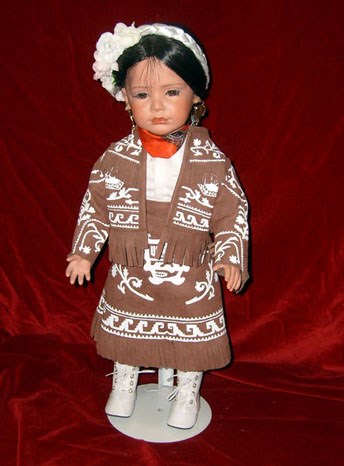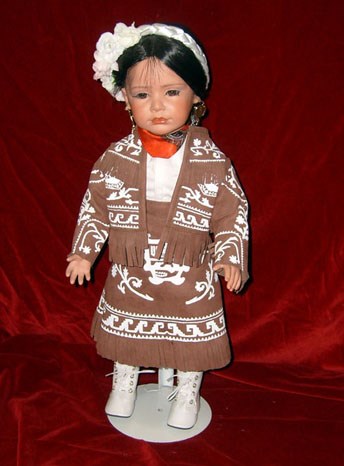
Capital: Ciudad Victoria A simple white blouse is worn beneath a matching fringed brown suede jacket and skirt, both heavily embroidered with white spiraling waves and the crest of the state of Tamaulipas. The state is a leading national producer of cattle and agriculture, including sugarcane, corn, tobacco, and cotton. The Huastecos live in the area known as the huasteca, and occupy parts of Tamaulipas, San Luis Potosi, Hidalgo, and Veracruz. Robust inhabitants of the thick forests and rugged mountains of the coastal region, the Huastecos enjoy the profusion of rivers and waterfalls, cultivating the rich soil, breeding livestock of excellent quality, and selling fruit and fresh fish - both of which they have in abundance. The Huastecos have the reputation of being as tough as the terrain they live on and, when they find free time, being equally lighthearted and tempestuous. At Mexico's northernmost border on the Gulf of America, Tamaulipas features the country's largest collection of lagoons - bodies of water separated from the ocean by sand banks that form a barrier along the coast. The Laguna Madre is the largest and best known. In the lagoons, the intermingling of salt and fresh water, and the nutrients delivered by the rivers create an environment rich with many species of fish including shrimp and oysters. However, these bodies of water are affected by aguas negras, (black waters) contaminated with waste, industrial chemicals, and agricultural insecticides and fertilizers. In addition to livestock and agriculture, fishing and tourism are also vital parts of Tamaulipas' economy. But gas and oil refining take place on a large scale, with pipelines carrying the state's output to different parts of Mexico. In ancient times, chapopote (tar) was used for cleaning teeth, as chewing gum, as writing ink, in construction, and in medicine. In colonial days, it was used as a protective coating on wooden ships. The border cities of Reynosa and Matamoros are industrial areas with many attractions for visitors from the U.S. Matamoros is an 18th century town named for a rebellious priest executed by the Spanish during the War of Independence. The first major battle of the Mexican-American War took place here. Mexican troops began firing shells across the Rio Grande only to have General Zachary Taylor and his men occupy the city before marching south. El Cielo, a biospheric reserve since 1985, offers refuge to almost 200 species of migratory birds, including quail and white-wing doves, along with some amphibians and mammals, such as whitetail deer, wild boar, badgers, and black bears. Did you know...? 
Capital: Ciudad Victoria Una sencilla blusa blanca se usa bajo un chaleco de gamuza café con barbitas y la falda, densamente bordada con ondas blancas en espiral. Tamaulipas es principal productor de ganado y agricultura, incluyendo caña de azúcar, maíz, tabaco y algodón. Los Huastecos toman su nombre de la región norteña llamada Huasteca. Este grupo indígena ocupa parte de los estados de Tamaulipas, San Luis Potosí, Hidalgo, y Veracruz. No muy lejos de la costa, los recios habitantes de los densos bosques y abruptas montañas, gozan de una abundante cantidad de ríos y cascadas, cultivan el suelo fértil, crían ganado de excelente calidad y venden fruta y pescado fresco. Tamaulipas es el estado más septentrional de México, tiene una amplia colección de lagunas, la más grande y mas conocida de ellas es la Laguna Madre. La mezcla de agua dulce y salada de las lagunas y los nutrientes que arrastran los ríos han hecho de ellas un medio embiente rico en especies animales como el pescado, camarón y ostras. Sin embargo, estas lagunas son afectadas por corrientes de aguas negras, contaminadas por desechos industriales, químicos e insecticidas agrícolas y fertilizantes. Además de la ganadería y la agricultura, existen otras actividades que son vitales para la economía de Tamaulipas tales como la industria pesquera y el turismo. También juegan un papel importante las refinerías de petróleo y gas, con tuberías que distribuyen este combustible a todas las regiones de México. En tiempos antiguos, el chapopote era utilizado para limpiar dientes, como goma de mascar, como tinita para escribir, en la construcción y en la medicina. Durante la colonia, fue utilizado sobre los barcos de madera para protección de casco. Las ciudades fronterizas de Reynosa y Matamoros son atractivas áreas industriales para los visitantes de EE UU. Matamoros es una ciudad del siglo 18 nombrada en honor de un sacerdote rebelde que fue ejecutado por los españoles durante la guerra de independencia. La primera gran batalla de la guerra méxico-americana ocurrió aquí. Las tropas mexicanas comenzaron a lanzar conchas a través de Río Bravo sólo para que el General Zachary Taylor y sus hombres ocupan la ciudad antes de ir hacia el sur. El Cielo es una reserva de la biosfera desde 1985, es un refugio que alberga a casi 200 especies de aves migratorias, tales como la codorniz y la paloma de ala blanca, así como algunos anfibios y mamíferos, como el venado cola blanca, el jablí, el tejón, y el oso negro. Sabías que...? |
Last updated: February 18, 2025
